| Solar eclipse of October 25, 2022 | |
|---|---|
 Partial from Saratov, Russia Partial from Saratov, Russia | |
 Map Map | |
| Type of eclipse | |
| Nature | Partial |
| Gamma | 1.0701 |
| Magnitude | 0.8623 |
| Maximum eclipse | |
| Coordinates | 61°36′N 77°24′E / 61.6°N 77.4°E / 61.6; 77.4 |
| Times (UTC) | |
| Greatest eclipse | 11:01:20 |
| References | |
| Saros | 124 (55 of 73) |
| Catalog # (SE5000) | 9558 |
A partial solar eclipse occurred at the Moon’s descending node of orbit on Tuesday, October 25, 2022, with a magnitude of 0.8623. A solar eclipse occurs when the Moon passes between Earth and the Sun, thereby totally or partly obscuring the image of the Sun for a viewer on Earth. A partial solar eclipse occurs in the polar regions of the Earth when the center of the Moon's shadow misses the Earth.
The eclipse was visible from Europe, Central Asia, West Asia, South Asia and from Northeast Africa. The maximal phase of the partial eclipse occurred on the West Siberian Plain in Russia near Nizhnevartovsk, where more than 82% of the Sun was eclipsed by the Moon. In India, the Sun was eclipsed during sunset ranging from 58% in the north and around 2% in the south. From Western Europe it appeared to be around 15-30% eclipsed. It was visible between 08:58 UTC, the greatest point of eclipse occurred at 11:00 UTC and it ended at 13:02 UTC.
Gallery
-
 Telescopic view from Milton Keynes, England, 10:02 UTC
Telescopic view from Milton Keynes, England, 10:02 UTC
-
 From Novate Milanese, Italy, 10:08 UTC
From Novate Milanese, Italy, 10:08 UTC
-
 From Lutkówka, Poland, 10:11 UTC
From Lutkówka, Poland, 10:11 UTC
-
 From Berlin, Germany, 10:24 UTC
From Berlin, Germany, 10:24 UTC
-
 From Žilina, Slovak Republic, 10:39 UTC
From Žilina, Slovak Republic, 10:39 UTC
-
 From Moscow, Russia, 10:47 UTC
From Moscow, Russia, 10:47 UTC
-
 From Poltava, Ukraine, 10:48 UTC
From Poltava, Ukraine, 10:48 UTC
-
 Telescopic view from Istanbul, Turkey, 11:02 UTC
Telescopic view from Istanbul, Turkey, 11:02 UTC
-
 Observed in Kiryat Ata, Israel
Observed in Kiryat Ata, Israel
-
 From Dushanbe, Tajikistan, 12:07 UTC
From Dushanbe, Tajikistan, 12:07 UTC
-
 From Bhubaneswar, India, 12:11 UTC
From Bhubaneswar, India, 12:11 UTC
-
 Animation from Belfort, France
Animation from Belfort, France
- A transit of a bird during the eclipse from Kumbakonam, India
-
 Birds passing by while eclipse is happening. Ankara, Turkey, at 10:43 UTC
Birds passing by while eclipse is happening. Ankara, Turkey, at 10:43 UTC
Eclipse details
Shown below are two tables displaying details about this particular solar eclipse. The first table outlines times at which the moon's penumbra or umbra attains the specific parameter, and the second table describes various other parameters pertaining to this eclipse.
| Event | Time (UTC) |
|---|---|
| First Penumbral External Contact | 2022 October 25 at 08:59:30.9 UTC |
| Equatorial Conjunction | 2022 October 25 at 10:04:55.9 UTC |
| Ecliptic Conjunction | 2022 October 25 at 10:49:51.4 UTC |
| Greatest Eclipse | 2022 October 25 at 11:01:20.0 UTC |
| Last Penumbral External Contact | 2022 October 25 at 13:03:26.7 UTC |
| Parameter | Value |
|---|---|
| Eclipse Magnitude | 0.86189 |
| Eclipse Obscuration | 0.82075 |
| Gamma | 1.07014 |
| Sun Right Ascension | 13h59m20.5s |
| Sun Declination | -12°10'17.0" |
| Sun Semi-Diameter | 16'05.0" |
| Sun Equatorial Horizontal Parallax | 08.8" |
| Moon Right Ascension | 14h01m10.9s |
| Moon Declination | -11°14'16.0" |
| Moon Semi-Diameter | 15'52.6" |
| Moon Equatorial Horizontal Parallax | 0°58'16.0" |
| ΔT | 70.9 s |
Eclipse season
See also: Eclipse cycleThis eclipse is part of an eclipse season, a period, roughly every six months, when eclipses occur. Only two (or occasionally three) eclipse seasons occur each year, and each season lasts about 35 days and repeats just short of six months (173 days) later; thus two full eclipse seasons always occur each year. Either two or three eclipses happen each eclipse season. In the sequence below, each eclipse is separated by a fortnight.
| October 25 Descending node (new moon) |
November 8 Ascending node (full moon) |
|---|---|
 |

|
| Partial solar eclipse Solar Saros 124 |
Total lunar eclipse Lunar Saros 136 |
Related eclipses
Eclipses in 2022
- A partial solar eclipse on April 30.
- A total lunar eclipse on May 16.
- A partial solar eclipse on October 25.
- A total lunar eclipse on November 8.
Metonic
- Preceded by: Solar eclipse of January 6, 2019
- Followed by: Solar eclipse of August 12, 2026
Tzolkinex
- Preceded by: Solar eclipse of September 13, 2015
- Followed by: Solar eclipse of December 5, 2029
Half-Saros
- Preceded by: Lunar eclipse of October 18, 2013
- Followed by: Lunar eclipse of October 30, 2031
Tritos
- Preceded by: Solar eclipse of November 25, 2011
- Followed by: Solar eclipse of September 23, 2033
Solar Saros 124
- Preceded by: Solar eclipse of October 14, 2004
- Followed by: Solar eclipse of November 4, 2040
Inex
- Preceded by: Solar eclipse of November 13, 1993
- Followed by: Solar eclipse of October 4, 2051
Triad
- Preceded by: Solar eclipse of December 25, 1935
- Followed by: Solar eclipse of August 26, 2109
Solar eclipses of 2022–2025
This eclipse is a member of a semester series. An eclipse in a semester series of solar eclipses repeats approximately every 177 days and 4 hours (a semester) at alternating nodes of the Moon's orbit.
| Solar eclipse series sets from 2022 to 2025 | ||||||
|---|---|---|---|---|---|---|
| Ascending node | Descending node | |||||
| Saros | Map | Gamma | Saros | Map | Gamma | |
119 Partial in CTIO, Chile |
April 30, 2022 Partial |
−1.19008 | 124 Partial from Saratov, Russia |
October 25, 2022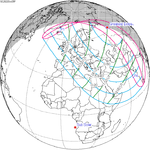 Partial |
1.07014 | |
129 Partial in Magetan, Indonesia |
April 20, 2023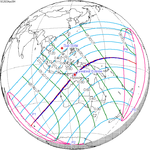 Hybrid |
−0.39515 | 134 Annularity in Hobbs, NM, USA |
October 14, 2023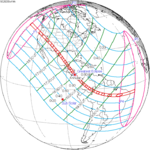 Annular |
0.37534 | |
139 Totality in Dallas, TX, USA |
April 8, 2024 Total |
0.34314 | 144 Annularity in Santa Cruz Province, Argentina |
October 2, 2024 Annular |
−0.35087 | |
| 149 | March 29, 2025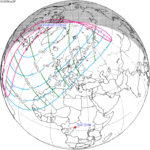 Partial |
1.04053 | 154 | September 21, 2025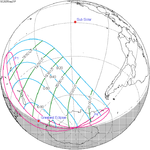 Partial |
−1.06509 | |
Saros 124
This eclipse is a part of Saros series 124, repeating every 18 years, 11 days, and containing 73 events. The series started with a partial solar eclipse on March 6, 1049. It contains total eclipses from June 12, 1211 through September 22, 1968, and a hybrid eclipse on October 3, 1986. There are no annular eclipses in this set. The series ends at member 73 as a partial eclipse on May 11, 2347. Its eclipses are tabulated in three columns; every third eclipse in the same column is one exeligmos apart, so they all cast shadows over approximately the same parts of the Earth.
The longest duration of totality was produced by member 39 at 5 minutes, 46 seconds on May 3, 1734. All eclipses in this series occur at the Moon’s descending node of orbit.
| Series members 43–64 occur between 1801 and 2200: | ||
|---|---|---|
| 43 | 44 | 45 |
 June 16, 1806 |
 June 26, 1824 |
 July 8, 1842 |
| 46 | 47 | 48 |
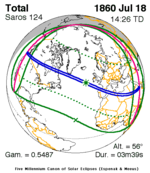 July 18, 1860 |
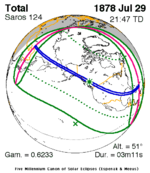 July 29, 1878 |
 August 9, 1896 |
| 49 | 50 | 51 |
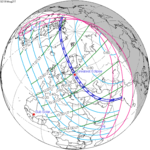 August 21, 1914 |
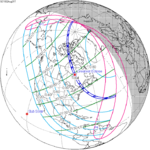 August 31, 1932 |
 September 12, 1950 |
| 52 | 53 | 54 |
 September 22, 1968 |
 October 3, 1986 |
 October 14, 2004 |
| 55 | 56 | 57 |
 October 25, 2022 |
 November 4, 2040 |
 November 16, 2058 |
| 58 | 59 | 60 |
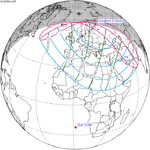 November 26, 2076 |
 December 7, 2094 |
 December 19, 2112 |
| 61 | 62 | 63 |
 December 30, 2130 |
 January 9, 2149 |
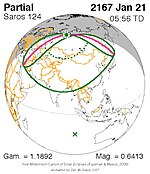 January 21, 2167 |
| 64 | ||
 January 31, 2185 | ||
Metonic series
The metonic series repeats eclipses every 19 years (6939.69 days), lasting about 5 cycles. Eclipses occur in nearly the same calendar date. In addition, the octon subseries repeats 1/5 of that or every 3.8 years (1387.94 days). All eclipses in this table occur at the Moon's descending node.
| 22 eclipse events between June 1, 2011 and October 24, 2098 | ||||
|---|---|---|---|---|
| May 31–June 1 | March 19–20 | January 5–6 | October 24–25 | August 12–13 |
| 118 | 120 | 122 | 124 | 126 |
 June 1, 2011 |
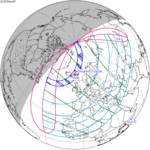 March 20, 2015 |
 January 6, 2019 |
 October 25, 2022 |
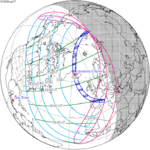 August 12, 2026 |
| 128 | 130 | 132 | 134 | 136 |
 June 1, 2030 |
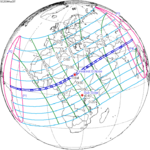 March 20, 2034 |
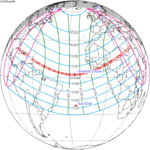 January 5, 2038 |
 October 25, 2041 |
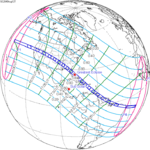 August 12, 2045 |
| 138 | 140 | 142 | 144 | 146 |
 May 31, 2049 |
 March 20, 2053 |
 January 5, 2057 |
 October 24, 2060 |
 August 12, 2064 |
| 148 | 150 | 152 | 154 | 156 |
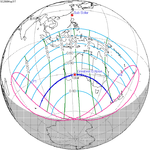 May 31, 2068 |
 March 19, 2072 |
 January 6, 2076 |
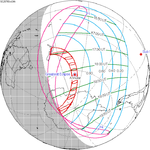 October 24, 2079 |
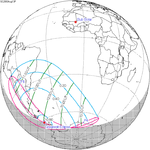 August 13, 2083 |
| 158 | 160 | 162 | 164 | |
 June 1, 2087 |
 October 24, 2098 | |||
Tritos series
This eclipse is a part of a tritos cycle, repeating at alternating nodes every 135 synodic months (≈ 3986.63 days, or 11 years minus 1 month). Their appearance and longitude are irregular due to a lack of synchronization with the anomalistic month (period of perigee), but groupings of 3 tritos cycles (≈ 33 years minus 3 months) come close (≈ 434.044 anomalistic months), so eclipses are similar in these groupings.
| Series members between 1837 and 2200 | ||||
|---|---|---|---|---|
 April 5, 1837 (Saros 107) |
 March 5, 1848 (Saros 108) |
 February 3, 1859 (Saros 109) |
 December 2, 1880 (Saros 111) | |
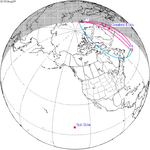 August 31, 1913 (Saros 114) |
 July 31, 1924 (Saros 115) |
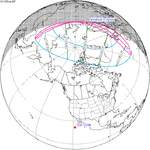 June 30, 1935 (Saros 116) | ||
 May 30, 1946 (Saros 117) |
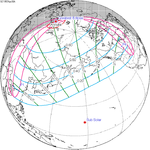 April 30, 1957 (Saros 118) |
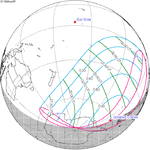 March 28, 1968 (Saros 119) |
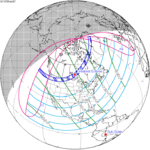 February 26, 1979 (Saros 120) |
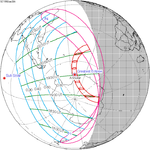 January 26, 1990 (Saros 121) |
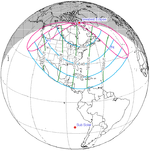 December 25, 2000 (Saros 122) |
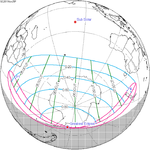 November 25, 2011 (Saros 123) |
 October 25, 2022 (Saros 124) |
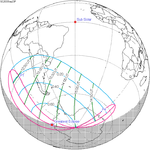 September 23, 2033 (Saros 125) |
 August 23, 2044 (Saros 126) |
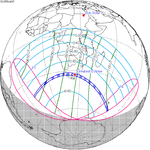 July 24, 2055 (Saros 127) |
 June 22, 2066 (Saros 128) |
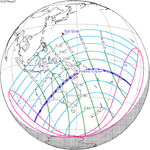 May 22, 2077 (Saros 129) |
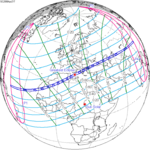 April 21, 2088 (Saros 130) |
 March 21, 2099 (Saros 131) |
 February 18, 2110 (Saros 132) |
 January 19, 2121 (Saros 133) |
 December 19, 2131 (Saros 134) |
 November 17, 2142 (Saros 135) |
 October 17, 2153 (Saros 136) |
 September 16, 2164 (Saros 137) |
 August 16, 2175 (Saros 138) |
 July 16, 2186 (Saros 139) |
 June 15, 2197 (Saros 140) | |
Inex series
This eclipse is a part of the long period inex cycle, repeating at alternating nodes, every 358 synodic months (≈ 10,571.95 days, or 29 years minus 20 days). Their appearance and longitude are irregular due to a lack of synchronization with the anomalistic month (period of perigee). However, groupings of 3 inex cycles (≈ 87 years minus 2 months) comes close (≈ 1,151.02 anomalistic months), so eclipses are similar in these groupings.
| Series members between 1801 and 2200 | ||
|---|---|---|
 March 14, 1820 (Saros 117) |
 February 23, 1849 (Saros 118) |
 February 2, 1878 (Saros 119) |
 January 14, 1907 (Saros 120) |
 December 25, 1935 (Saros 121) |
 December 4, 1964 (Saros 122) |
 November 13, 1993 (Saros 123) |
 October 25, 2022 (Saros 124) |
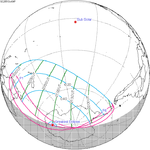 October 4, 2051 (Saros 125) |
 September 13, 2080 (Saros 126) |
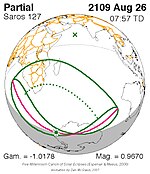 August 26, 2109 (Saros 127) |
 August 5, 2138 (Saros 128) |
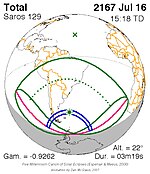 July 16, 2167 (Saros 129) |
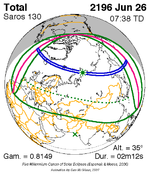 June 26, 2196 (Saros 130) |
|
References
- "October 25, 2022 Partial Solar Eclipse". timeanddate. Retrieved 13 August 2024.
- "Surya Grahan 2022: Photos of October's Solar Eclipse, Captured From Mumbai, Chennai, Indore and Other Indian Cities | Weather.com". The Weather Channel.
- Archie, Ayana (October 25, 2022). "The last solar eclipse of the year happens today". NPR.
- Nicioli, Taylor (October 25, 2022). "The last solar eclipse of the year can be seen today". CNN.
- Fine, Camille. "Last solar eclipse of the year in photos: Marvel at this astronomical phenomenon". USA TODAY.
- "Partial Solar Eclipse of 2022 Oct 25". EclipseWise.com. Retrieved 13 August 2024.
- van Gent, R.H. "Solar- and Lunar-Eclipse Predictions from Antiquity to the Present". A Catalogue of Eclipse Cycles. Utrecht University. Retrieved 6 October 2018.
- "NASA - Catalog of Solar Eclipses of Saros 124". eclipse.gsfc.nasa.gov.


